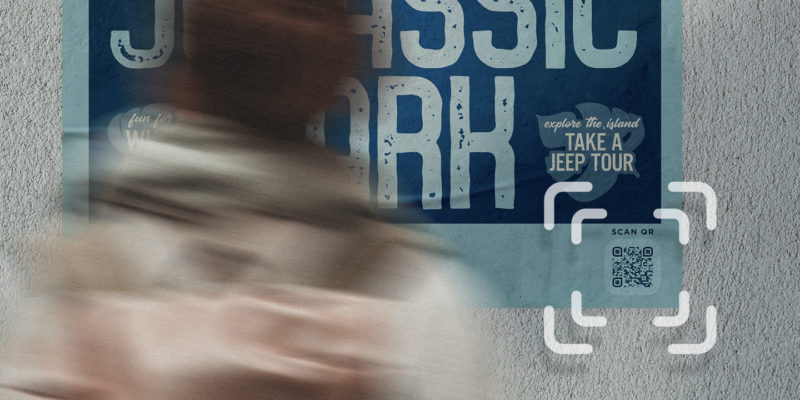In the mid-1990s, websites were all the rage. Not every company had one, but if you had any vision or understanding of what the future would hold, you knew you needed one. It was around that same time — when digital and print advertising first converged — that companies began placing urls on their print materials. They were giving the consumer another way to connect with and learn more about their brand. Fast forward to 2024, and most brands are still doing the same thing with their print pieces.
The time to change that is now. Augmented Reality should be considered as part of every print campaign, whether that be a poster, billboard, digital signage, or standee display. AR is now more accessible than ever, and it can take your print materials to a new dimension of engagement.
The “AR is here” conversation probably seems like it’s been happening for a while. But until recently, that conversation often stopped in its tracks when presented with barriers such as long download times and prohibitive costs. That all changed with the development of web-based AR. It eliminates the barriers, making it easier for consumers to access your experience, and it reduces production costs.
Augmented Reality has now reached a point where it should be considered as part of every print campaign, whether that be a poster, billboard, digital signage, or standee display.
Because of those changes and others, we believe the time to embrace AR as an extension of your print materials is now. Let’s take a deeper dive into the five reasons why.
- Memorable Engagement
Print ads can be effective, but we challenge you to show us a simple print ad that engages a consumer the way a video does. With web-based AR, you can turn that ad into an animated piece of art, showcase a video, bring characters to life, create a 360-degree interactive environment, or create a window into a new world. Instead of a flat, static print ad or banner, you have the opportunity to create an endless amount of engagement that will make an impact your print ad could only dream of on its own.
- No More Downloads Required
As digital marketers, we learned long ago that the fewer clicks away an intended destination is, the more likely it is that someone will arrive there. This same concept holds true with AR, where for years, usage depended on users downloading apps to their phones. The problem was, no one wanted to download an app for a one-time experience. Additionally, depending on their network and the size of the application, that download could take awhile. And just as quickly as someone became interested in your experience, they had lost interest. It was too much effort for the user. The maturation of web-based AR into a powerful platform changes the game, because it’s now possible to skip the download while creating a powerful experience. With no download, you now have a much quicker path to engagement. While there are some technical and media advantages to using a social media app to create your AR experience, none of them provide the universal access that web-based AR provides for a one-time engagement your print materials provide.
- Cost-Effective Production
The costs of producing an AR experience come way down when you’re using web-based code libraries. Open source JavaScript libraries such as A-Frame (https://aframe.io/), Three.js (https://threejs.org/) and BabylonJS (https://www.babylonjs.com/) handle the first half of the equation make it easy to create, position and light 3D objects in a 3D scene in a web browser. Other aspects, like image targeting, placing objects in the user’s space, and facial recognition can be managed with some open-source technology, but are generally better handled with platforms like Niantic’s 8th Wall (https://www.8thwall.com). Additionally, you can (and should) create a strategy that allows for reusable/re-skinnable experiences. By planning ahead and understanding the goals and objectives you have for both the short and long term, you can create efficiencies that will have your CFO praising your ability to maximize budgets. In addition to reduced development costs, you’re also expanding the effectiveness of the print campaign and extending the engagement. Thus, you’re increasing the ROI of the media dollars already spent on the print ad by adding additional content that maximizes the effectiveness of your media spend.
- QR Codes are Now Ubiquitous
In the not-so-distant past, a QR code in itself was a barrier to entry. No more. The pandemic provided a massive paradigm shift in this area. The main way this changed was that restaurants adopted touchless menus to reduce germ spread. Those digital menus were made possible by QR codes. And just like that, your grandparents knew how to scan a QR code with their phone. Almost 100 million QR scans are expected in the U.S. alone in 2025.1 And really, the only thing keeping that number from being two or three times higher is that more marketers haven’t embraced them. In fact, 75% of consumers are willing and expecting to use more QR codes in the future.2
- It’s All Trackable
You can’t attach a tracking pixel to a print ad, but you can track how many folks use your AR experience. And this allows you to understand just how effective your ad can be. You can see what users are clicking on, how long they stay in the experience and whether or not they complete it. We’ve developed experiences that have averaged over 10 minutes per visit. It’s incredible how long people will engage. If you consider that a typical print ad will be viewed for a few seconds, the idea of getting someone to spend minutes with your ad is an attractive proposition.
The next time you’re planning a print campaign, and every time thereafter, don’t forget to consider what’s possible with web-based Augmented Reality. Drive more engagement and brand equity with an experience that takes your ad to the next dimension.
1https://www.statista.com/statistics/1297768/us-smartphone-users-qr-scanner/
2https://shorturl.at/emEM7


